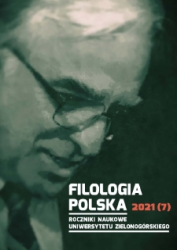Feminity and metaphysics in Jean-Claude Briesseau’s films
Keywords
Abstract
French director Jean-Claude Brisseau (1944-2019) started his career as a social realist. Over time, he gradually abandoned his harsh semidocumentary approach to filmmaking and adopted a more visually refined style. The imagery in his films reflected metaphysical and often esoteric contents. Searching for meaning in life, some of his characters became able to rise above the triviality of everyday material existence. The artist’s belief in the existence of a transcendent world was closely associated with his admiration for the female body. He saw the ideal aesthetic representation of beauty. Brisseau demonstrated his affection for the „eternal feminine” in such films as Sound and Fury (De bruit et de fureur, 1987), Céline (1992), Secret Things (Choses secrètes, 2002) and À l’aventure (2008). Almost all of his pictures prove his strong affinity with surrealist’ ideals.
References
Bonnaud F., Anti-Social Realism: Jean-Claude Brisseau, „Film Comment” 2004, nr 1-2, [anti-social-realism-jean-claude-brisseau].
[Google Scholar]
Boutroy P., Kurz O., Jean-Claude Brisseau, „Séquences” 1993, nr 162, s. 42.
[Google Scholar]
Brisseau J.-C., Mes dates clés. Par Jean-Claude Brisseau, „Liberation” 16.10.2002, [mes-dates-cles-par-jean-claude-brisseau_418656].
[Google Scholar]
de Baecque A., „Il a un vrai projet pour les femmes”, „Liberation” 13.09.2006, [il-a-un-vrai-projet-pour-les-femmes_51090].
[Google Scholar]
Dubosc A., Boivent J., Jean-Claude Brisseau on Filming Women [wywiad], „Purple Magazine” 2013, nr 20, [jean-claude-brisseau].
[Google Scholar]
Janicka K., Światopogląd surrealizmu, Warszawa 1985.
[Google Scholar]
Kaganski S., Les Inrockuptibles, 25 ans d’insoumission, Paris 2011.
[Google Scholar]
Nelepo B., Opening the Gates of Night. Jean-Claude Brisseau’s „La fille de nulle part”, „Cinema Scope” 2012, nr 53, [opening-the-gates-of-night-jean-claude-brisseaus-la-fille-du-nulle-part].
[Google Scholar]
Orzechowska J., Odkrycie, „Film” 1992, nr 22.
[Google Scholar]
Vecchi Ph., Maroussia Dubreuil, Marie Allan et Lise Bellynck. Entretien, [w:] Les Anges Exterminateurs, Paris 2006.
[Google Scholar]
Preview
Downloads
Published
How to Cite
Issue
Section
Categories
Copyright & License

This work is licensed under a Creative Commons Attribution-NonCommercial-NoDerivatives 4.0 International License.
Copyrights (a). In principle, authors who are not employed by the University of Zielona Góra retain the copyright, including publishing rights to the articles, without restrictions.
Copyrights (b). In principle, authors who are employed by the University of Zielona Góra, do not retain the copyright, including publishing rights to the articles. In such cases the copyright holder is the University of Zielona Góra.
Print ISSN
2450-3584-
Abstract207










































